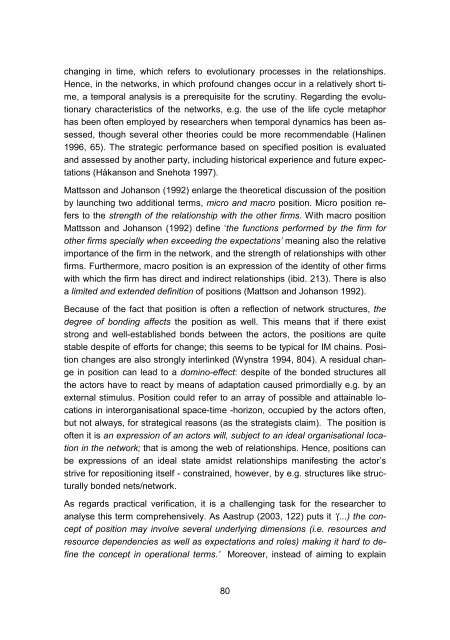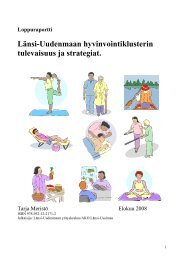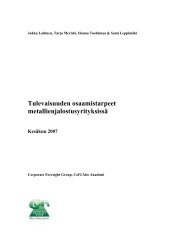849954 sisus
849954 sisus
849954 sisus
Create successful ePaper yourself
Turn your PDF publications into a flip-book with our unique Google optimized e-Paper software.
changing in time, which refers to evolutionary processes in the relationships.<br />
Hence, in the networks, in which profound changes occur in a relatively short time,<br />
a temporal analysis is a prerequisite for the scrutiny. Regarding the evolutionary<br />
characteristics of the networks, e.g. the use of the life cycle metaphor<br />
has been often employed by researchers when temporal dynamics has been assessed,<br />
though several other theories could be more recommendable (Halinen<br />
1996, 65). The strategic performance based on specified position is evaluated<br />
and assessed by another party, including historical experience and future expectations<br />
(Håkanson and Snehota 1997).<br />
Mattsson and Johanson (1992) enlarge the theoretical discussion of the position<br />
by launching two additional terms, micro and macro position. Micro position refers<br />
to the strength of the relationship with the other firms. With macro position<br />
Mattsson and Johanson (1992) define ‘the functions performed by the firm for<br />
other firms specially when exceeding the expectations’ meaning also the relative<br />
importance of the firm in the network, and the strength of relationships with other<br />
firms. Furthermore, macro position is an expression of the identity of other firms<br />
with which the firm has direct and indirect relationships (ibid. 213). There is also<br />
a limited and extended definition of positions (Mattson and Johanson 1992).<br />
Because of the fact that position is often a reflection of network structures, the<br />
degree of bonding affects the position as well. This means that if there exist<br />
strong and well-established bonds between the actors, the positions are quite<br />
stable despite of efforts for change; this seems to be typical for IM chains. Position<br />
changes are also strongly interlinked (Wynstra 1994, 804). A residual change<br />
in position can lead to a domino-effect: despite of the bonded structures all<br />
the actors have to react by means of adaptation caused primordially e.g. by an<br />
external stimulus. Position could refer to an array of possible and attainable locations<br />
in interorganisational space-time -horizon, occupied by the actors often,<br />
but not always, for strategical reasons (as the strategists claim). The position is<br />
often it is an expression of an actors will, subject to an ideal organisational location<br />
in the network; that is among the web of relationships. Hence, positions can<br />
be expressions of an ideal state amidst relationships manifesting the actor’s<br />
strive for repositioning itself - constrained, however, by e.g. structures like structurally<br />
bonded nets/network.<br />
As regards practical verification, it is a challenging task for the researcher to<br />
analyse this term comprehensively. As Aastrup (2003, 122) puts it ‘(...) the concept<br />
of position may involve several underlying dimensions (i.e. resources and<br />
resource dependencies as well as expectations and roles) making it hard to define<br />
the concept in operational terms.’ Moreover, instead of aiming to explain<br />
80








